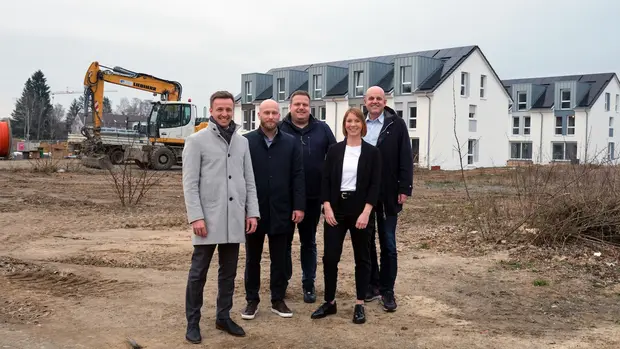
Stadtwerke Gießen is using all available roofs to generate solar power in the new Philosophenhöhe neighbourhood. This means cheap and clean electrical energy for the people who live here.
In the east of Giessen, north of Grünberger Strasse and roughly at the level of the Waldstadion, the Philosophenhöhe neighbourhood is currently being built. Over the next few months, the Depant company will be building a total of 66 detached houses and 14 residential and commercial buildings with 124 flats and up to ten commercial units on the approximately 3.2 hectare site. The Giessen-based property developer brought Stadtwerke Giessen (SWG) on board early on in the planning phase. This was because the municipal building authority attached strict conditions to the approval of the project: at least half of the total roof area must be fitted with photovoltaic modules. In addition, a high proportion of renewable energy for heating and the integration of the entire infrastructure into the Flex-Quartier research project were required. "Such a challenging task requires strong partners, well thought-out concepts and a functioning cooperation. SWG was the first port of call for us as a valued regional and efficient contact due to their proven and successful collaboration on previous projects," recalls Kai Bülow, Managing Director of Depant.
Smart alternative
Unlike district heating, which is now fully accepted and even favoured by many, the topic of photovoltaics (PV) often proves to be complicated for property developers, particularly in view of the complex administrative and tax law hurdles. "Installing the systems on every roof as standard and selling them with the property would also cause prices to rise significantly," Thimo Rieger points out. He developed the project at SWG and describes the smart alternative for a property developer: "We rent the roof areas, install the solar systems, operate them and offer the electricity generated at particularly favourable conditions. Directly on site and exclusively."
The technical term for this business model is tenant electricity. "Resident electricity would actually be a better term," says Lisa Müller. The state-certified business economist manages the project at SWG. This is because not only tenants benefit from the attractive SWG offer, but also owners who use their property themselves. Incidentally, tenant electricity is not limited to solar power from the respective roof. When the sun is not shining, SWG supplies pure green electricity as part of this offer - at the same conditions, of course. "Tenant electricity will cost 29.95 cents per kilowatt hour from January 2024, which is more than ten per cent lower than the basic supply tariff," calculates Lisa Müller. At 115 euros per year, the basic price is 13.52 euros cheaper than the basic supply tariff.
Important to know in this context: Anyone living in the Philosophenhöhe neighbourhood can purchase tenant electricity from SWG. "The offer speaks for itself. And people are increasingly looking for ways to do something for the climate themselves," Andreas Fuchs, Head of Sales at SWG, is convinced and adds: "We assume that the majority would like to purchase tenant electricity."
38 roofs, eleven partial systems
SWG is having PV modules with an output of around 707 kilowatts peak installed on a total of 38 roofs - including carports and garages. This means that SWG will use 51.8 per cent of the total available roof area for solar power production, even exceeding the requirement imposed on the property developer by the city. "We always combine several individual systems on the buildings into a larger one," says Lisa Müller, describing the procedure. When all the buildings are completed, there will be eleven of these larger subsystems. And thus eleven independent tenant electricity models. "This is the best way for us to follow the development of the various construction phases," explains Thimo Rieger.
Those responsible at SWG anticipate an electricity yield of 614,000 kilowatt hours per year after the final expansion. Around 250,000 kilowatt hours of this should flow into tenant electricity. This will cover between 40 and 60 per cent of the neighbourhood's demand. The relatively wide range is essentially explained by four factors that need to be taken into account: the number of people, their consumption behaviour, the size of the combined sub-systems and the orientation of the individual modules.
Still a lot to do
So far, 52 houses and flats have already been occupied and construction of the rest of the neighbourhood is progressing as planned. "As things stand today, we expect to be able to complete the entire neighbourhood project in 2026," predicts Kai Bülow. There is still a lot to do before then. Also for Thimo Rieger and Lisa Müller. After all, SWG is not only taking care of district heating connections and tenant electricity, but is also involved in the increasingly important charging infrastructure. "We expect to install and operate charging points in the future multi-storey car park. Charging will be possible here with our e-fuelling app," announces Andreas Fuchs. With this offer, Depant wants to usefully supplement the extensive charging concept, which includes individual charging options for cars and bicycles for all building and flat residents as well as an e-car sharing and e-cargo bike sharing offer.
The Philosophenhöhe neighbourhood is an impressive example of what regionally rooted, well-coordinated partners can achieve. Admittedly, the families living here benefit first and foremost from modern, energy-efficient buildings. But the impact of the project should not be underestimated. After all, Depant and SWG are proving that climate-friendly construction is affordable. The neighbourhood is also making an important contribution to achieving the ambitious goal of making Giessen climate-neutral by 2035.

